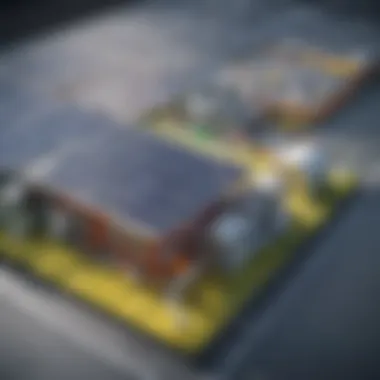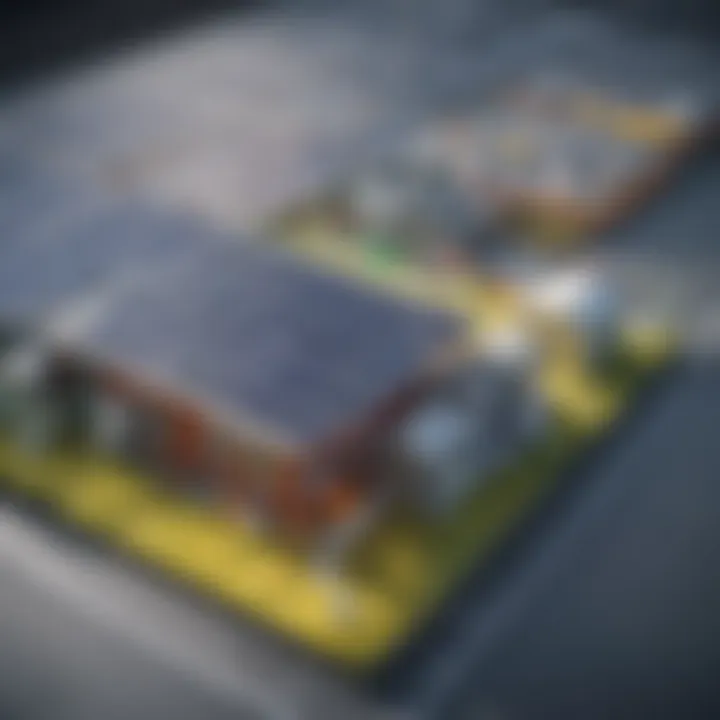Exploring Personal Solar Power Systems Today


Intro
As the world marches steadily towards sustainable energy solutions, personal solar power systems stand as a beacon of innovation and practicality. Solar energy has transitioned from a niche luxury to a necessity in modern living. With rising energy costs and the urgent call for environmental stewardship, understanding solar power's potential extends beyond the realms of eco-enthusiasts; it beckons investors, homeowners, and future-oriented cities alike.
This article will provide a thorough examination of personal solar power systems, spotlighting the key components that make these systems tick, the installation intricacies that can often daunt newcomers, and the financial implications that arise from investing in solar technology. Navigating these waters may seem complex, but armed with real-world case studies and a clear understanding of technology advances, individuals can traverse this landscape with confidence.
We will explore how personal solar power can fit into our daily lives, offering a comprehensive guide that encompasses considerations for investments in solar energy solutions, geared towards those who wish to make informed choices for themselves and the environment. By demystifying solar power systems, we aim to illuminate the path toward energy independence and sustainability.
In this journey, whether you are here to invest, evaluate financial products, or seek advice from industry experts, there’s a wealth of information waiting to be uncovered. What follows will arm you with the knowledge needed to navigate the personal solar power landscape effectively and intelligently.
Understanding Personal Solar Power Systems
Personal solar power systems represent a pivotal shift in how individuals and businesses approach energy consumption and sustainability. As global awareness of environmental issues burgeons, understanding these systems only becomes more essential. They allow homeowners and businesses to harness energy from the sun—a clean, renewable source—and reduce reliance on traditional electricity. This translates not only to significant cost savings but also contributes to lowering one's carbon footprint.
The adoption of solar technology is not merely a trend; it’s a proactive step towards energy independence. People are realizing that they can empower themselves by generating their own electricity, thereby gaining control over their utility bills.
Definition and Purpose
In simple terms, a personal solar power system refers to a collection of equipment designed to convert sunlight into usable electricity for personal or commercial use. The primary purpose of such systems is to decrease dependence on grid energy and provide a sustainable power source. They achieve this through an arrangement of components, each playing a crucial role in the energy generation process.
The significance of solar power systems is best captured in their ability to democratize energy access. For instance, a residential system can provide power during outages, create a buffer against fluctuating energy prices, and even allow for net metering, where surplus energy is sold back to the grid. In today’s context, where energy sustainability is paramount, understanding these systems is not just advantageous; it is imperative.
Key Components of a Solar Power System
Understanding the key components is essential to grasping how personal solar power systems function effectively. Each part is integral, and together they encapsulate the whole mechanism of energy generation and utilization.
Photovoltaic Panels
Photovoltaic panels, commonly known as solar panels, are at the heart of any solar power system. They convert sunlight into electricity through the photovoltaic effect. The main characteristic of these panels is their efficiency in capturing solar energy—thus, they are often seen as a beneficial choice for energy seekers.
One unique feature of modern photovoltaic technology is the advancement in monocrystalline panels. These panels boast higher efficiency rates and occupy less space compared to their polycrystalline counterparts. However, they tend to come at higher costs. This means that while they are premium in performance, one must weigh their budget against the long-term energy output benefits.
Batteries
Batteries in solar power systems serve as storage units for excess energy generated during sunlight hours. This stored energy can be utilized during periods when the sun isn’t shining, ensuring a consistent power supply. The ongoing push towards solar energy adoption has rendered battery storage a popular choice, particularly with the rise of technologies like lithium-ion batteries which have significantly lower maintenance needs and longer life spans.
However, the initial investment for high-capacity batteries can be steep. It's vital to consider both the upfront cost and the potential savings on energy bills in the long run. More so, environmental impact concerns regarding battery disposal should also be on a potential investor’s checklist.
Inverters
Inverters play an invaluable role by converting direct current (DC) electricity generated by solar panels into alternating current (AC) electricity, which is the standard for home and business use. The efficiency of an inverter directly affects the overall performance of a solar power system.
A significant characteristic of modern inverters is their ability to maximize energy output through maximum power point tracking (MPPT). This ensures that the system operates at its highest efficiency regardless of changing conditions. However, it’s important to be aware that inverters may require replacement over the lifespan of a solar power system, introducing potential hidden costs.
Charge Controllers
Finally, charge controllers are integral for regulating the voltage and current coming from the solar panels to the batteries. Their primary function is to prevent battery overcharging and extend lifespan. Selecting a suitable charge controller—be it PWM (Pulse Width Modulation) or MPPT, can optimize performance.
Well-matched charge controllers can significantly enhance the efficiency of battery storage, reinforcing the overall goals of energy independence and sustainability. That said, oversight in complexity could lead to sub-optimal setups and increased risks of battery degradation, therefore, prudent selection and configuration remain paramount.
Types of Solar Power Systems
Understanding the types of solar power systems is crucial for anyone considering investing in this technology. Different systems serve varied purposes and needs, with some better suited for certain environments or user requirements than others. The choice can impact not only installation costs but also long-term returns, maintenance, and environmental benefits. Here, we delve into three primary types of solar power systems—grid-tied, off-grid, and hybrid systems—each with its own set of features and advantages.
Grid-Tied Systems
A grid-tied solar power system connects directly to the local electricity grid, allowing users to harness solar energy while still maintaining access to grid power. This setup is often seen as a practical choice for homeowners who wish to reduce their energy bills without completely relying on solar energy. With grid-tied systems, when the sun shines, the solar panels generate electricity which can either be used immediately, stored in batteries for later use, or sent back to the grid.
Benefits of grid-tied systems include:


- Cost-Effectiveness: These systems typically have lower installation costs due to the absence of large battery systems, making them a popular choice among new solar users.
- Net Metering: Customers can benefit from net metering incentives, where excess energy produced during sunny periods can be credited to them, reducing future bills.
- Low Maintenance: Fewer components mean less upkeep, making grid-tied systems easier to manage in the long run.
While the advantages are significant, there are considerations as well. A grid-tied system will not function during a power outage unless specific equipment is installed, which means that users could face energy shortages during emergencies.
Off-Grid Systems
Off-grid solar power systems stand apart. They operate independently from the utility grid, making them ideal for remote areas or for those who wish to be energy-independent. Off-grid systems generally require battery storage to retain energy, ensuring that users have power even when the sun isn’t shining.
Key features of off-grid systems include:
- Energy Independence: Users are empowered to generate and use their energy, reducing dependency on external power sources.
- Ideal for Remote Locations: For homes and communities far from the grid, off-grid systems provide a reliable power solution where none existed before.
- Sustainability: This setup can drastically reduce a location’s carbon footprint, contributing to broader environmental goals.
However, off-grid systems come with challenges. Initial investment can be significantly higher due to the need for batteries and more sophisticated technology. Regular maintenance of these components is also essential to facilitate continued operation.
Hybrid Systems
Hybrid solar power systems effectively blend the elements of grid-tied and off-grid solutions. They provide the advantage of conventional grid power while allowing for energy storage options, creating a flexible system that caters to many needs and situations.
Some key insights about hybrid systems include:
- Flexibility: Users can opt to draw power from both their solar panels and the grid, depending on energy availability and cost.
- Battery Back-Up: Hybrid systems typically include storage solutions, ensuring that energy is available during peak demand times or outages.
- Maximized Efficiency: By utilizing both solar and grid energy, these systems can optimize energy use, catering to both daily needs and unexpected demand spikes.
Yet, the complexity of hybrid systems can lead to higher initial setup costs and more variance in maintenance requirements. It’s essential for users to evaluate their long-term energy needs before investing.
"Choosing the right type of solar power system is pivotal. It’s not just about saving money, but about aligning your energy needs with the right technology."
In closing, selecting the appropriate solar power system helps facilitate a smoother transition to renewable energy and maximize the benefits for the user. Whether you lean towards grid-tied, off-grid, or a hybrid solution, understanding these options can make your investment more effective, leading to both financial and environmental benefits.
The Installation Process
The installation of a personal solar power system is a fundamental phase that significantly influences its efficiency and long-term performance. Properly executing this process can maximize energy production and ensure the system operates harmoniously with the existing electrical setup. Installers need to pay attention to various critical aspects during this process, not just to ensure that panels are in the right place, but also that the entire system meets regulatory standards and is financially sound.
Initial Assessment
Site Evaluation
When discussing site evaluation, it becomes apparent that this is a major first step in the installation process. Essentially, site evaluation aligns the solar setup with local conditions, ensuring that the panels receive optimal sunlight. Key characteristics of this evaluation include assessing shading from trees or buildings, roof orientation, and inclination. For someone looking to invest in solar energy, understanding these features can provide confidence in the decision-making process.
The unique aspect of site evaluation is its potential impact on energy generation. A well-executed evaluation can indicate how much energy the system is likely to produce, which directly links to return on investment. However, there are disadvantages as well; unanticipated site issues could lead to increased costs or delays further down the installation road. Therefore, a thorough site assessment is beneficial for all parties involved.
Energy Needs Analysis
Energy needs analysis represents another critical component of the initial assessment. It involves comprehensively reviewing how much energy is required by the household or business and determining the size of the solar system accordingly. This characteristic is vital, as it helps tailor the system to the specific needs of the user. By identifying peak usage times and calculating energy consumption habits, a homeowner can optimize solar energy production effectively.
The unique feature of energy needs analysis lies in its predictive nature. It aids in estimating potential savings and assists in making informed adjustments, which ultimately contributes to the overall sustainability of the energy model. However, a downside may be the complexity involved; if the analysis is inaccurate, it may lead to oversizing or undersizing the system. A well-planned energy needs analysis is, therefore, unquestionably advantageous for achieving maximum efficiency.
Permitting and Regulations
Navigating the maze of permitting and regulations can feel like dodging a minefield for many. Before installation even begins, it's critical to understand local laws relating to solar energy. This might include obtaining necessary permits and adhering to building codes. Regulations can vary significantly, depending on the region, and can affect everything from design to installation timelines. The importance of this step cannot be understated—it ensures that the system operates legally and safely within community guidelines. Additionally, knowing the requirements upfront can help mitigate future disputes or costly alterations.
Installation Steps
Mounting Panels
Mounting panels is one of those pivotal steps that literally puts solar energy into action, acting as the cornerstone of any solar system setup. Proper mounting is vital not only because it ensures the panels are secure and positioned for optimal sun exposure but also because it determines the long-term viability of the entire system. Characteristically, panels must be installed at a precise angle that accounts for climate, seasonality, and geographical location; this is why employing skilled professionals is common.
One of the unique benefits of effective mounting is that it minimizes wear and tear on the panels, prolonging their lifespan and enhancing energy capture. Conversely, improper mounting can lead to complications or faults in the system. This is why rigour in this step is necessary for all solar installations.
Electrical Connections
Following up from the physical aspects of the installation, we have electrical connections, which are equally as significant. This part of the process involves linking the solar panels to the inverter and the main electrical panel. Ensuring proper electrical connections contributes to the efficiency of energy transfer and protects the entire system from faults.


The important characteristic of well-executed electrical connections is their role in maximizing energy efficiency. The unique point here is that if connections are improperly made, they can lead to energy losses and diminish the value of the entire installation. Foregoing shortcuts in this phase will pay off in operational efficiency and reliability.
System Testing
After all installations are complete, the moment for system testing arrives. This final stage runs through each component's functionality and verifies that everything works as intended. Testing should include evaluating the performance of the inverter, the safety of electrical connections, and the overall energy output of the panels.
Testing is imperative as it catches any potential issues early on, preventing disruptions in energy flow and ensuring everything is in order before fully operational. The unique advantage of this stage is that it provides peace of mind for stakeholders, knowing they are investing in a system functioning at peak capacity. However, one must also be wary; failing to conduct diligent tests could lead to future malfunctions or decreased energy output.
Financial Considerations
The financial aspects of adopting a personal solar power system encapsulate various crucial elements that can significantly influence an individual's or business's decision-making process. Understanding these components is vital for prospective investors. The right financial strategy can make a solar installation not just a smart choice, but an economical one too. With the continual increase in energy costs, scrutinizing the fiscal implications becomes essential for maximizing the return on investments in solar technologies.
Cost Breakdown
Initial Investment
When discussing the initial investment in a personal solar power system, it’s important to recognize that this initial outlay includes various elements. This encompasses purchasing photovoltaic panels, inverters, batteries, and, if necessary, mounting equipment. The price can vary considerably based on the specific products chosen and the size of the installation. One key characteristic of initial investment is that it represents a significant upfront cost. However, this investment can often be looked at not just in isolation but as a long-term strategy geared towards reducing future energy expenses.
The unique feature of this investment is its potential to yield savings over time, despite the high initial cost. Adopting solar energy allows users to generate their own electricity, thus insulating them somewhat from rising utility prices. However, it’s also paramount to consider that if the installation is poorly managed, or if low-quality components are selected, the long-term savings may not materialize as anticipated, which leads to a risk many investors must weigh.
Maintenance Costs
Maintenance costs are another vital aspect that can greatly impact the financial viability of a personal solar system. Generally, these costs are relatively low as most systems require minimal upkeep. Regular cleaning of solar panels to prevent dirt and debris accumulation may be the most involved aspect. The key characteristic of maintenance costs is predictability—most investors can anticipate these costs, making budgeting easier.
The unique feature here is that while ongoing maintenance can be a small fraction of the initial investment, it is still an essential factor to keep in mind as it is often neglected. Overlooking necessary maintenance can lead to efficiency drops, shortening the lifespan of the system, and ultimately affecting an investor’s bottom line. Evaluating these costs up front can provide a clearer picture of the overall investment value, aligning expectations with reality.
Financial Incentives
Tax Credits
Tax credits stand out as a significant factor that can ease the financial burden of installing solar power systems. These credits directly reduce the amount owed on income tax, thus lowering overall costs. The notable characteristic of tax credits is that they can be quite generous, often covering a substantial percentage of the initial investment. For instance, there are federal and state credits available that might appeal directly to potential buyers.
What's unique about tax credits is that they encourage investment in renewable energy technology by providing immediate financial relief. However, it’s vital to remain informed since these incentives can change due to policy shifts and may have expiration dates. If not utilized correctly, investors can miss out on potential savings, so understanding the nuances of tax credits becomes crucial.
Rebates
Rebates represent another attractive financial incentive aimed at encouraging the adoption of solar energy. These cash back offers, which can vary from state to state or even from utility providers, essentially make solar systems more affordable. A key characteristic of rebates is that they are often tied to the performance or energy output of installed systems.
The unique aspect of rebates is how they can provide upfront reductions in costs. This makes solar energy systems more accessible, especially for homeowners who may feel daunted by the initial financial commitment. Yet, it's important to understand the conditions attached to these rebates as they may require specific performance metrics or compliance with set regulations. Failing to meet these criteria can result in fewer financial benefits than initially expected.
Environmental Impact
The role of personal solar power systems extends well beyond financial savings and energy independence; it plays a pivotal part in addressing some of the pressing environmental issues that the world currently faces. By harnessing the sun's abundant energy, individuals can substantially lessen their impact on the planet. Understanding the environmental implications of transitioning to solar power is essential for anyone looking to make conscious decisions about their energy consumption and sustainability practices.
Reduction of Carbon Footprint
Transitioning to solar energy significantly contributes to the reduction of carbon emissions produced by conventional fossil fuels. When households or businesses choose photovoltaic systems, they effectively lower their reliance on coal, oil, and natural gas, which are notorious for releasing greenhouse gases. Here’s how the carbon footprint diminishes:
- Declining Emissions: Every kilowatt-hour of electricity generated by solar panels reduces the demand for electricity produced by burning fossil fuels. This translates to fewer emissions released into the atmosphere, such as carbon dioxide (CO2) and methane (C).
- Sustainable Production: Solar panel manufacturing has improved in efficiency, with companies focusing on reducing emissions throughout the production phase. Energy-intensive processes are increasingly powered by renewable sources.
- Lifecycle Benefits: While solar panels do have a carbon footprint associated with their manufacturing, installation, and eventual disposal, over their lifespan, they offset far more carbon than what is initially emitted. Generally, solar panels can save thousands of pounds of CO2 in their operational lifetime.
Beyond these immediate benefits, investing in personal solar power systems demonstrates a commitment to reducing the environmental impact. This not only encourages more sustainable practices among peers but also reflects an understanding of the long-term benefits associated with solar technology.
"Switching to solar can be a personal revolution, making a substantial difference in our collective journey towards sustainability."
Sustainability Perspectives
Evaluating solar power from a sustainability perspective reveals its role as a cornerstone in the global fight against environmental degradation. It’s not merely about clean energy; it’s about fostering a culture of sustainable practices and responsibility. Some key insights include:
- Resource Conservation: Solar energy is renewable and inexhaustible, meaning it doesn't deplete the earth's natural resources. Unlike oil or gas, sunlight is a resource that can be harnessed day after day without concern for future limitations.
- Local Ecosystems: Utilizing solar power can support local ecosystems by decreasing the need for practices that destroy landscapes and habitats, such as mining and drilling for fossil fuels. Also, solar array installations can coexist with agricultural activities, hence promoting dual land use.
- Promoting Clean Air: By replacing fossil fuel energy sources, solar power significantly improves air quality. Cleaner air results in better health outcomes for communities, reducing health costs related to pollution-induced diseases.
- Encouraging Innovation: The rise of personal solar systems promotes technological innovation in sustainability. With advancements in battery storage and efficient panels, the sector continuously develops, enhancing performance and longevity.


Case Studies and Practical Applications
Case studies and practical applications play a crucial role in understanding personal solar power systems. They not only provide concrete examples of how solar power is being harnessed in various contexts but also illustrate the tangible benefits and considerations involved in such investments. By examining real-world scenarios, potential investors and interested parties can glean insights into what works, what doesn’t, and the factors that can influence the success of a solar power system.
In this article, we explore two major areas of application: residential installations and commercial applications. Each category presents unique challenges, solutions, and outcomes, revealing the diverse capabilities of personal solar energy systems.
Residential Installations
Residential installations of solar power systems have gained momentum in recent years, as homeowners look for ways to reduce energy costs and lessen their environmental footprint. Many families have transitioned to solar energy to empower their homes with sustainable electricity. A notable case is seen in the enthusiastic adoption of rooftop solar panels. For instance, a family in San Diego decided to install a system that not only reduced their monthly electricity bill but also served as a backup during power outages. The specifics of their system included:
- Photovoltaic Panels: High-efficiency panels positioned to maximize sunlight capture
- Batteries: Lithium-ion batteries that stored extra energy for use during high-demand times
- Inverter: An inverter to convert direct current (DC) from the panels to alternating current (AC) for home use
In summary, the family's investment paid off within a couple of years, highlighting the long-term financial benefits that can be achieved through residential solar power systems while promoting energy independence.
Commercial Applications
When it comes to commercial applications, businesses are often looking at the bottom line, along with their energy savings. Companies that adopt solar power systems not only decrease overhead costs but can also enhance their corporate social responsibility image. An example here is a warehouse in Nevada that installed a large-scale solar array on its rooftop. This system has enabled them to:
- Significantly cut energy expenses, leading to lower operating costs and higher profit margins
- Stabilize energy prices by using generated power instead of relying solely on the grid
- Become a more attractive option for eco-conscious partners by demonstrating a commitment to sustainability
"Embracing solar energy not only benefits the environment, but it also turns into a profitable long-term investment for businesses."
Through both residential and commercial perspectives, the case studies presented reveal the versatility and effectiveness of personal solar power systems, providing a comprehensive understanding of their practical applications. Investors can learn what elements to consider and how these systems can be optimally structured to yield maximum benefits.
Future Trends in Solar Energy
As the world pivots towards clean energy, the future trends in solar energy play a pivotal role in shaping the landscape of personal solar power systems. Understanding these trends is crucial for investors and stakeholders in the energy sector. They not only reflect technological digs, but they also unveil a roadmap of how solar energy can evolve to meet modern challenges. This segment will explore how advancements in technology and shifts in policy can lead to significant improvements in solar power systems.
Technological Advancements
The emergence of innovative technologies is a shining beacon in the realm of solar energy. Advances in solar panel efficiency, storage solutions, and grid integration have positioned solar energy as a frontrunner in sustainable solutions.
- Solar Cell Efficiency: New materials like perovskite are gradually making their way into commercial applications, promising higher efficiency rates compared to traditional silicon cells. With efficiency rates previously capped at approximately 20%, these innovations are pushing the envelope higher, nearing 30% and beyond.
- Battery Storage Enhancements: As solar energy relies heavily on sunlight, effective storage systems have become indispensable. Innovations in lithium-ion battery technology, alongside breakthroughs in solid-state batteries, are enhancing energy storage capabilities. This allows homeowners to store excess energy generated during the day for use during cloudy days or nighttime.
- Smart Inverters: The introduction of smart inverters has revolutionized how solar harnesses energy. These devices facilitate better grid synchronization and real-time tracking of energy production and consumption. This contributes to the overall reliability of the solar power systems, ensuring they operate at peak efficiency.
"Technological innovations are not just enhancing efficiency; they are redefining how we think about and utilize solar power."
In summation, ongoing research and development are key drivers of change in solar technologies. Investors should keep a keen eye on these advancements, as they pave the way for enhanced returns on solar investments.
Policy Developments
Shifting gears, one cannot overlook the influence of policy developments on the solar landscape. Governments and regulatory bodies worldwide are increasingly recognizing the urgent need for sustainable energy solutions. This has resulted in a plethora of policies designed to bolster solar energy adoption.
- Incentives: Many regions are introducing tax incentives and rebates for homeowners and businesses that invest in solar power systems. These incentives reduce the barrier to entry, making solar investment more attractive. Such programs could see local implementation, varying from state to state.
- Renewable Energy Standards: Governments are pushing forward with legislation that mandates a certain percentage of energy must come from renewable sources. These standards provide a framework for both citizens and corporations to shift towards solar energy, further catalyzing investments.
- Grid Modernization Initiatives: As solar energy progresses, so too must the infrastructure that supports it. Policies aimed at modernizing the grid, such as integrating renewable energy sources, play a critical role. These initiatives help ensure that the existing energy framework can accommodate growing solar integration while maintaining reliability for users.
Ending and Recommendations
In wrapping up the exploration of personal solar power systems, it's clear that these systems aren't just an emerging trend—they're a substantial shift in how we think about energy. The advantages they offer, ranging from financial savings to environmental benefits, underline their growing significance in contemporary energy discussions. Moreover, understanding the implications detailed in this article can empower potential investors, allowing them to make informed decisions about adopting solar technologies.
A well-rounded grasp of the key components, types of systems, and installation processes can help individuals navigate this complex landscape with confidence. From an economic standpoint, the long-term savings on energy bills alongside available incentives create a compelling case for investment.
"Investing in personal solar power systems isn't just about reducing electricity bills; it's about contributing to a sustainable future."
However, potential investors must also be aware of the challenges involved, such as local regulations and policies, which can sometimes act as hurdles. Therefore, staying abreast of developments in solar technology and governmental incentives is crucial to maximizing benefits.
By fostering a thorough understanding of these elements, individuals can harness the power of the sun not just to power their homes but to invest in a greener future.
Summary of Key Points
- Innovative Energy Solutions: Personal solar power systems represent a progressive step towards sustainable energy.
- Diverse Options: There are various system types—grid-tied, off-grid, and hybrid—each with unique advantages and considerations.
- Financial Benefits: Potential savings and financial incentives make solar investments appealing metrics.
- Environmental Impact: Utilizing solar energy contributes to a reduction in carbon emissions and promotes sustainability.
- Continued Education: Keeping informed on technological advancements and policies can benefit investors over time.
Advice for Potential Investors
When considering an investment in personal solar power systems, the following strategies can help secure a successful venture:
- Conduct Thorough Research: Understand the advantages and limitations of each type of system. Consider what aligns with your energy needs and goals.
- Calculate Return on Investment: Evaluate potential savings over time versus initial costs and maintenance. Making projections can clarify financial viability.
- Stay Updated on Incentives: Keep an eye on local, state, and federal incentives that might offset installation costs. Websites like www.energy.gov or local utility websites often have useful resources.
- Consult Experts: Engage with solar energy consultants to navigate the complexities of installation and financing options. Their insights can prove invaluable.
- Consider Future Trends: Keep an ear to the ground regarding new technologies and evolving policies that could influence the long-term success of your investment.
Finally, view investment in solar not merely as an economic decision, but as a step toward a sustainable future and energy independence.



